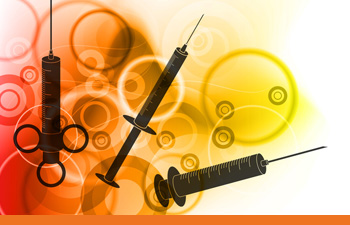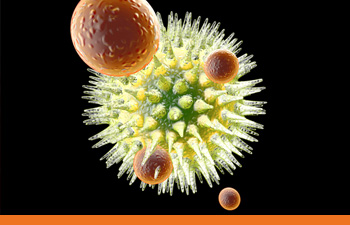Courtesy of MedPage Today
Updated: Aug 29, 2013
Migraine was linked to structural brain changes, particularly in the presence of aura, a meta-analysis showed.
White matter brain lesions appeared 68% more often in migraineurs with aura than in those without migraine; a trend for 34% elevated risk of white matter in migraine patients without aura didn't reach significance, Messoud Ashina, MD, PhD, of the Danish Headache Center at Glostrup Hospital in Copenhagen, and colleagues found.
Clinically-silent infarct-like abnormalities and brain volume changes also correlated with migraine, they reported online in Neurology.
However, it's still not clear how these changes arise or whether they have any clinical significance, the group cautioned. "Traditionally, migraine has been considered a benign disorder without long-term consequences for the brain," they noted.
MRI imaging to exclude secondary causes of headache often turns up such abnormalities that worry both neurologists and patients, the group noted.
"Patients with white matter abnormalities can be reassured," they recommended. "Patients with infarct-like lesions should be evaluated for stroke risk factors. Volumetric MRI remains a research tool."
Eli Feen, MD, a neurologist at Saint Louis University in St. Louis, agreed with the researchers on evaluating stroke risk factors in patients with infarct-like brain lesions on MRI. But he suggested it should be done regardless of migraine status, and instead be based on age and the prevalence of stroke.
"What is reassuring is that when we look at the brain MRI of a migraine patient, we don't have to be concerned about the lesions or abnormalities of the white matter suggesting something more malignant," he said in an interview.
Without knowing the true clinical significance of the findings, clinicians should focus on making sure that migraine is taken seriously and treated properly, commented Emily Rubenstein Engel, MD, associate director of the Dalessio Headache Center at Scripps Clinic in San Diego.
"It is a disease that can -- and should -- be managed well, so that patients are minimally symptomatic and have minimal injury to their brain," she said in an email to MedPage Today.
But while there's growing evidence that migraineurs are at slightly elevated stroke risk overall, there's no evidence that preventing migraine reduces that risk, argued Andrew Charles, MD, director of the headache research and treatment program at the University of California Los Angeles.
"Patients with migraine, particularly those with aura along with their migraine attacks, should work to reduce other stroke risk factors like high blood pressure, high cholesterol, and smoking," he suggested in an email to MedPage Today.
The meta-analysis included six population-based studies and 13 clinic-based studies that looked for MRI abnormalities in migraineurs from 1989 through 2013.
The prevalence of white matter abnormalities ranged from 4% to 59% across the studies.
Pooled analysis of the four that reported on this measure indicated an odds ratio of 1.68 for migraine with aura compared with no-migraine controls (95% CI 1.07-2.65).
The odds of white matter lesions was 1.34 for migraine without aura but missed statistical significance (95% CI 0.96-1.87).
One of the studies, CAMERA-2, suggested no link between white matter abnormality progression and anti-migraine therapy; another indicated no increased risk of stroke, heart attack, or cardiovascular death with triptan medication.
"While this result is reassuring, robust conclusions are limited due to confounding by indication," Ashina's group cautioned.
For silent infarct-like lesions, the likelihood across two pooled studies was 44% higher for migraineurs with aura than without aura (P=0.04), but no statistically significant association emerged for either compared with controls.
"It is unclear whether silent infarct-like lesions predispose to or are associated with development of clinical stroke," the researchers pointed out.
Also, whereas infarct-like lesions are associated with cognitive decline and dementia in the elderly, CAMERA-2 and another study didn't show a link to cognitive decline in migraine and other severe types of headache, they added.
Theories are that these lesions could represent a combination of episodic focal brain under-perfusion or a manifestation of hypertensive small-vessel disease.
Of the nine studies that looked at brain volume, seven indicated reduced grey matter density in brain regions in migraineurs compared with controls. Another study indicated increased grey matter density in the periaqueductal gray (a region involved in pain processing) and the dorsolateral pons regions only in migraine with aura.
"Additional longitudinal studies are needed to determine the differential influence of migraine without and with aura, to better characterize the effects of attack frequency and to assess longitudinal changes in brain structure and function," the group concluded.
Limitations included heterogeneity in patient samples, selection criteria, headache characteristics, test methodology, timing, and data interpretation, as well as the possibility of residual or unmeasured confounding and unclear directionality of associations.
*****
nutraMetrix Isotonix® OPC-3®. One of OPC-3's key ingredients is pycnogenol. Conclusive scientific studies show the power of Pycnogenol related to migraines (Chayasirisobhon S. Use of a Pine Bark Extract and Antioxidant Vitamin Combination Product as Therapy for Migraine in Patients Refractory to Pharmacologic Medication. Headache 2006 May; 46(5): 788-793.)
If you suffer from migraines, I strongly urge you to consider nutraMetrix Isotonix® OPC-3®. What if the only thing you have to lose is your migraines?
What Makes nutraMetrix Isotonix OPC-3® Unique*:
nutraMetrix
Isotonix OPC-3® is an isotonic-capable food supplement that is made
from a combination of bilberry, grape seed, red wine and pine bark
extracts, and citrus extract bioflavonoids, all found to be powerful
antioxidants. Oligomeric proanthocyanidins (OPCs) are bioflavonoids
(complex organic plant compounds) found in fruits, vegetables and
certain tree barks that provide exceptional nutritional benefits to the
human body. Studies have shown OPCs to be up to 20 times more powerful
than vitamin C and 50 times more powerful than vitamin E in neutralizing
free radicals. nutraMetrix Isotonix OPC-3 contains the only isotonic
form of Pycnogenol® in the world. Pycnogenol is a natural plant extract
from the bark of the French maritime pine tree and the most clinically
researched and potent bioflavonoid.*Isotonic, which means “same pressure,” bears the same chemical resemblance of the body’s blood, plasma and tears. All fluids in the body have a certain concentration, referred to as osmotic pressure. The body’s common osmotic pressure, which is isotonic, allows a consistent maintenance of body tissues. In order for a substance to be absorbed and used in the body’s metabolism, it must be transported in an isotonic state.
Isotonix® dietary supplements are delivered in an isotonic solution. This means that the body has less work to do to in obtaining maximum absorption. The isotonic state of the suspension allows nutrients to pass directly into the small intestine and be rapidly absorbed into the bloodstream. With Isotonix products, little nutritive value is lost, making the absorption of nutrients highly efficient while delivering maximum results.
* These statements have not been evaluated by the Food and Drug Administration.
This product(s) is not intended to diagnose, treat, cure or prevent any disease.
This product(s) is not intended to diagnose, treat, cure or prevent any disease.




 “Toxicity is the only way to explain this
explosion,” Dr. Rodier offered, “the
genes have not changed – pollution has
gotten worse.”
“Toxicity is the only way to explain this
explosion,” Dr. Rodier offered, “the
genes have not changed – pollution has
gotten worse.” The
debate over the cause (or causes) of
autism continues amongst medical
professionals and researchers. While some
people suspect immunizations, the CDC has
consistently
refuted the link between
autism and vaccinations. Some parents
disagree, noting that
many vaccines contain mercury and
aluminum, heavy metals used as
preservatives and considered toxic for
the brain, especially in
children’s maturing brains. There’s still
plenty of debate over the relationship
between vaccines and autism. While Dr.
Rodier’s totally against polluting the
body with any added toxins, he’s quick to
remind us that vaccines are often
necessary for keeping other potential
health problems at bay.
The
debate over the cause (or causes) of
autism continues amongst medical
professionals and researchers. While some
people suspect immunizations, the CDC has
consistently
refuted the link between
autism and vaccinations. Some parents
disagree, noting that
many vaccines contain mercury and
aluminum, heavy metals used as
preservatives and considered toxic for
the brain, especially in
children’s maturing brains. There’s still
plenty of debate over the relationship
between vaccines and autism. While Dr.
Rodier’s totally against polluting the
body with any added toxins, he’s quick to
remind us that vaccines are often
necessary for keeping other potential
health problems at bay. While
researchers cannot yet promise ways to
replace specific missing bacteria with
targeted probiotics strains, they are
busy working on this problem. The “old”
type of research focused on examining the
benefits of isolated bacteria strains
cultivated in labs.
While
researchers cannot yet promise ways to
replace specific missing bacteria with
targeted probiotics strains, they are
busy working on this problem. The “old”
type of research focused on examining the
benefits of isolated bacteria strains
cultivated in labs.